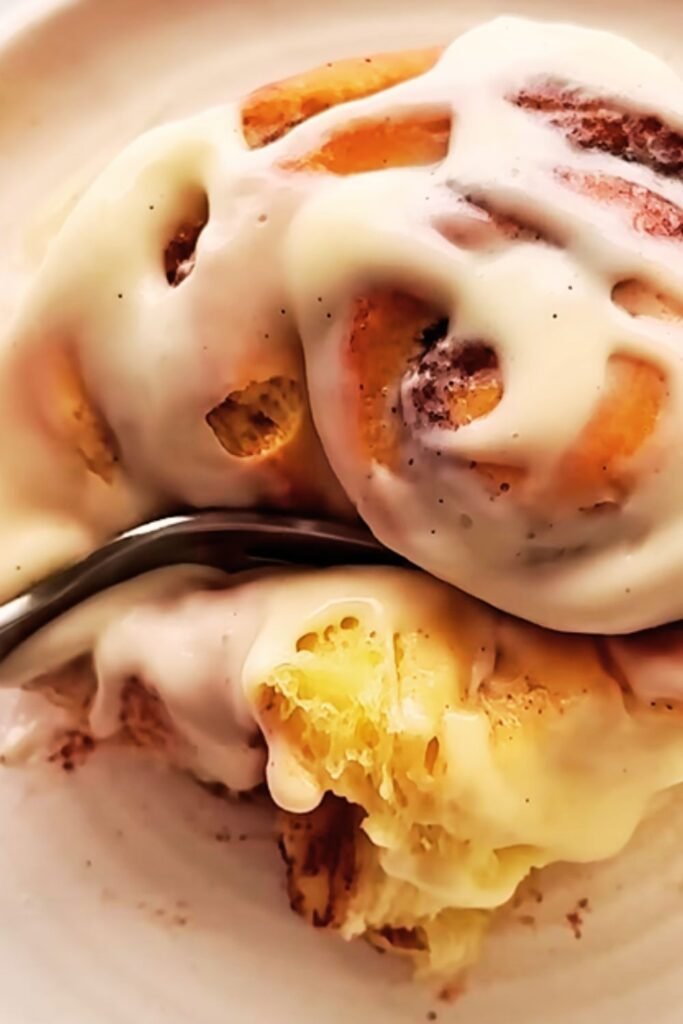There’s something magical about the aroma of cinnamon rolls baking in the oven – that warm, sweet scent that instantly transforms any kitchen into a cozy haven. I’ve always been captivated by this beloved pastry, but as someone who values both indulgence and nutrition, I found myself craving a version that could satisfy my sweet tooth while supporting my health goals. That’s when I discovered the game-changing power of Greek yogurt in cinnamon roll recipes.
Greek yogurt cinnamon rolls represent a brilliant fusion of comfort food satisfaction and nutritional consciousness. By incorporating Greek yogurt into both the dough and filling, these rolls achieve an incredibly tender texture while boosting protein content significantly. I’ve experimented with countless variations over the years, and I can confidently say that this approach creates rolls that are just as decadent as traditional versions, if not more so.
Understanding the Greek Yogurt Advantage
Greek Yogurt: A thick, strained yogurt that contains significantly more protein than regular yogurt, typically offering 15-20 grams of protein per serving while maintaining a creamy, tangy flavor profile.
Protein Enhancement: The process of incorporating protein-rich ingredients into traditionally carbohydrate-heavy recipes to improve nutritional balance without sacrificing taste or texture.
Fermentation Benefits: The natural fermentation process in Greek yogurt introduces beneficial probiotics that can support digestive health and add subtle flavor complexity to baked goods.
The science behind using Greek yogurt in baking fascinates me. The lactic acid in yogurt acts as a natural tenderizer, breaking down gluten strands to create an incredibly soft crumb. Meanwhile, the protein content adds structure and helps retain moisture, resulting in rolls that stay fresh longer than their traditional counterparts.
Essential Ingredients and Their Roles
Creating perfect Greek yogurt cinnamon rolls requires understanding how each ingredient contributes to the final product. I’ve learned through trial and error that quality ingredients make an enormous difference in the outcome.
Dough Components
| Ingredient | Quantity | Primary Function | Nutritional Benefit |
|---|---|---|---|
| Plain Greek Yogurt | 1 cup | Moisture, tenderness, protein | 20g protein, probiotics |
| All-purpose Flour | 3 cups | Structure, gluten development | Carbohydrates, B vitamins |
| Active Dry Yeast | 2¼ tsp | Leavening, flavor development | B vitamins, minerals |
| Honey | ¼ cup | Sweetness, moisture retention | Antioxidants, natural sugars |
| Unsalted Butter | 4 tbsp (melted) | Richness, flavor | Fat-soluble vitamins |
| Large Eggs | 2 | Binding, structure, richness | Complete protein, choline |
| Salt | 1 tsp | Flavor enhancement, gluten control | Electrolyte balance |
| Baking Powder | 1 tsp | Additional lift | None significant |
Filling and Topping Elements
| Component | Ingredients | Purpose | Health Notes |
|---|---|---|---|
| Cinnamon Filling | Ground cinnamon, brown sugar, Greek yogurt | Flavor, moisture, protein boost | Antioxidants, blood sugar regulation |
| Cream Cheese Glaze | Greek yogurt, cream cheese, powdered sugar | Rich finishing touch | Additional protein, calcium |
| Optional Nuts | Chopped pecans or walnuts | Texture, healthy fats | Omega-3 fatty acids, fiber |
| Vanilla Extract | Pure vanilla extract | Aromatic enhancement | Antioxidant compounds |

Step-by-Step Preparation Method
My approach to making Greek yogurt cinnamon rolls has evolved over years of experimentation. I’ve discovered that certain techniques make the difference between good rolls and extraordinary ones.
Preparing the Dough
I start by activating the yeast in warm water (around 110°F) with a pinch of sugar. This step is crucial – the mixture should become foamy within 5-10 minutes, indicating healthy, active yeast. If it doesn’t foam, I start over with fresh yeast to avoid disappointment later.
In a large mixing bowl, I combine the Greek yogurt, melted butter, honey, and beaten eggs. The Greek yogurt should be at room temperature to prevent shocking the yeast when combined. I whisk these wet ingredients until smooth, creating a creamy base that will yield incredibly tender rolls.
The flour incorporation requires patience and attention. I add the flour gradually, mixing with a wooden spoon until a shaggy dough forms. The dough will appear stickier than traditional bread dough due to the Greek yogurt content – this is exactly what we want. Resist the urge to add excess flour, as this will result in dense, heavy rolls.
Kneading and First Rise
Kneading Greek yogurt dough differs from traditional bread dough. I knead for about 8-10 minutes until the dough becomes smooth and elastic, but it will remain slightly tacky. This tackiness is the Greek yogurt working its magic, ensuring tender results.
For the first rise, I place the dough in a greased bowl, cover with a damp towel, and let it rise in a warm, draft-free location for 60-90 minutes. The dough should nearly double in size. I’ve found that a slightly longer rise time enhances flavor development and creates better texture.
Creating the Perfect Filling
The filling represents where creativity truly shines. My signature approach combines traditional cinnamon-sugar with a Greek yogurt component that adds moisture and protein. I mix 2 tablespoons of Greek yogurt with ½ cup brown sugar, 2 tablespoons ground cinnamon, and a pinch of salt. This creates a spreadable paste that distributes evenly and prevents dry spots in the finished rolls.

Assembly Technique
Rolling the dough requires a gentle touch. On a lightly floured surface, I roll the dough into a 12×18 inch rectangle, maintaining even thickness throughout. The Greek yogurt filling spreads easily with an offset spatula, and I leave a ½-inch border on one long edge to ensure proper sealing.
When rolling the dough, I start with the filled edge and roll tightly but not aggressively. Too much pressure can squeeze out the filling. I seal the seam by pinching it closed with my fingers.
For cutting, I use unflavored dental floss or a sharp knife, making clean cuts to maintain the spiral pattern. I’ve learned that sawing motions can compress the rolls, so quick, decisive cuts work best.
Second Rise and Baking
The assembled rolls go into a greased 9×13 inch pan, leaving space between each roll for expansion. The second rise takes 30-45 minutes, during which the rolls should touch each other and appear puffy.
I preheat the oven to 375°F and bake for 22-28 minutes until the tops are golden brown and the internal temperature reaches 190°F. The Greek yogurt helps prevent overbaking by maintaining moisture throughout the cooking process.
Nutritional Comparison and Benefits
Understanding the nutritional advantages of Greek yogurt cinnamon rolls helps justify this healthier indulgence. I’ve calculated the approximate nutritional differences between traditional and Greek yogurt versions.
Per Roll Nutritional Analysis
| Nutrient | Traditional Roll | Greek Yogurt Roll | Improvement |
|---|---|---|---|
| Calories | 420 | 385 | -35 calories |
| Protein | 6g | 12g | +100% |
| Total Fat | 18g | 14g | -22% |
| Saturated Fat | 11g | 8g | -27% |
| Carbohydrates | 62g | 58g | -6% |
| Fiber | 2g | 2g | No change |
| Sugar | 28g | 24g | -14% |
| Calcium | 80mg | 140mg | +75% |
| Probiotics | 0 CFU | 1 billion CFU | Significant addition |
The protein boost particularly excites me because it helps stabilize blood sugar levels and increases satiety. These rolls actually keep me satisfied longer than traditional versions, making them a more practical choice for breakfast or snacking.
Flavor Variations and Creative Adaptations
Over the years, I’ve developed numerous variations that showcase the versatility of the Greek yogurt base. Each adaptation maintains the nutritional benefits while exploring different flavor profiles.
Seasonal Variations
Autumn Spice: I incorporate pumpkin puree into the dough along with warming spices like nutmeg, allspice, and cardamom. The result captures the essence of fall in every bite.
Summer Berry: Fresh or freeze-dried berries folded into the filling create bursts of natural sweetness and additional antioxidants.
Winter Citrus: Orange zest in both the dough and glaze brightens the rolls and adds vitamin C.
Spring Herb: Surprisingly delightful, a subtle addition of fresh thyme or rosemary creates sophisticated, bakery-worthy rolls.
International Inspirations
Mediterranean Style: I add lemon zest, honey, and chopped pistachios for a Greek-inspired variation that pays homage to the yogurt’s origins.
Scandinavian Cardamom: Ground cardamom replaces some of the cinnamon, creating rolls reminiscent of Swedish kanelbullar.
Mexican Chocolate: Cocoa powder, chili powder, and vanilla create complex, warming rolls perfect for adventurous palates.

Troubleshooting Common Issues
Through my years of perfecting this recipe, I’ve encountered and solved numerous challenges that home bakers often face.
Dough Consistency Problems
Too Sticky: While Greek yogurt dough should be slightly tacky, excessively sticky dough usually indicates too much liquid or insufficient flour. I add flour one tablespoon at a time until manageable.
Too Dry: Dense, difficult-to-roll dough often results from too much flour or yogurt that wasn’t at room temperature. I incorporate warm water, one tablespoon at a time, until the dough softens.
Won’t Rise: Failed rising typically stems from dead yeast, too-hot liquid (which kills yeast), or too-cold environment. I always test yeast activation and ensure optimal rising conditions.
Baking Challenges
Uneven Browning: This usually indicates oven hot spots or incorrect rack positioning. I rotate the pan halfway through baking and ensure the rack is positioned in the center of the oven.
Dry Texture: Overbaking is the primary culprit. Greek yogurt helps prevent this, but I always check for doneness a few minutes before the recommended time.
Filling Leakage: Overfilling or insufficient sealing causes this issue. I’ve learned that less filling, properly sealed, creates better results than generous amounts that leak out.
Storage and Reheating Strategies
Proper storage maintains the quality and safety of Greek yogurt cinnamon rolls while preserving their superior texture.
Short-term Storage
Freshly baked rolls stay optimal at room temperature for 2-3 days when stored in an airtight container. The Greek yogurt actually helps maintain moisture longer than traditional recipes.
Long-term Preservation
For longer storage, I wrap individual rolls in plastic wrap and freeze for up to three months. The protein and fat content from Greek yogurt helps prevent freezer burn and maintains texture during thawing.
Reheating Methods
| Method | Time | Temperature | Best For |
|---|---|---|---|
| Microwave | 15-20 seconds | High power | Single servings |
| Oven | 5-8 minutes | 350°F | Multiple rolls |
| Toaster Oven | 3-5 minutes | 325°F | 1-2 rolls |
| Air Fryer | 2-3 minutes | 320°F | Crispy exterior desired |
Serving Suggestions and Pairings
Greek yogurt cinnamon rolls shine as standalone treats, but thoughtful pairings can elevate the experience. I’ve discovered several combinations that complement the tangy sweetness perfectly.
Beverage Pairings
Coffee remains the classic choice, but I particularly enjoy these rolls with medium-roast varieties that don’t overpower the delicate yogurt notes. For non-coffee drinkers, chai tea, English breakfast tea, or even hot chocolate create delightful combinations.
Fresh fruit juices, particularly orange or apple, provide bright acidity that balances the richness. For something special, I sometimes prepare fresh-squeezed grapefruit juice, which creates an unexpectedly sophisticated pairing.
Complementary Foods
When serving for brunch, I often accompany the rolls with fresh seasonal fruit, particularly berries that echo the tartness of Greek yogurt. Greek yogurt parfaits create a thematic continuity while adding additional protein to the meal.
For heartier appetites, turkey or chicken sausage provides protein balance without overwhelming the delicate flavors. I avoid heavy breakfast meats that compete with the rolls’ nuanced taste profile.
Health Considerations and Dietary Modifications
The beauty of Greek yogurt cinnamon rolls lies in their adaptability to various dietary needs and health considerations.
Dietary Adaptations
Gluten-Free Version: I’ve successfully adapted this recipe using a high-quality gluten-free flour blend (with xanthan gum). The Greek yogurt helps maintain structure that gluten-free baking often struggles to achieve.
Reduced Sugar: Natural sweeteners like stevia or monk fruit can replace some sugar, though I recommend maintaining some traditional sweetener for proper texture and yeast food.
Dairy-Free Option: Coconut yogurt can substitute for Greek yogurt, though the protein content will be lower and the texture slightly different.
Blood Sugar Management
The increased protein content helps moderate blood sugar spikes compared to traditional cinnamon rolls. I’ve found that enjoying these rolls as part of a balanced meal rather than alone provides optimal blood sugar stability.
Questions and Answers
Q. Can I make the dough ahead of time for convenience?
Yes, absolutely! I often prepare the dough the night before and refrigerate it after the first rise. Cold dough is actually easier to roll out, and the extended fermentation time develops more complex flavors. Just bring it to room temperature before shaping, which takes about 30 minutes.
Q. Why do my rolls sometimes turn out dense instead of fluffy?
Dense rolls usually result from either over-mixing the dough, using too much flour, or not allowing adequate rising time. The Greek yogurt dough should remain slightly sticky – resist adding extra flour. Also, ensure your yeast is fresh and active, as dead yeast won’t provide proper lift.
Q. How can I tell when the rolls are perfectly baked?
I use an instant-read thermometer to check the internal temperature, which should reach 190°F. Visually, the tops should be golden brown, and when you gently press the center of a roll, it should spring back. The Greek yogurt helps prevent overbaking, but don’t rely solely on color.
Q. Can I freeze the unbaked rolls for later?
Definitely! After shaping the rolls and placing them in the pan, cover tightly and freeze for up to one month. When ready to bake, thaw them in the refrigerator overnight, then allow them to come to room temperature and complete their final rise before baking. This adds about 45 minutes to an hour to the process.
Q. What’s the best way to achieve an even cinnamon distribution?
I’ve found that mixing the cinnamon with the brown sugar and Greek yogurt creates a paste that spreads more evenly than dry cinnamon-sugar mixture. Make sure to leave a small border when spreading to prevent filling from leaking out during rolling.
Q. My glaze always seems too thick or too thin – what’s the secret?
The key is adding liquid gradually and at room temperature. I start with powdered sugar and cream cheese or Greek yogurt, then add milk or cream one teaspoon at a time until I reach the desired consistency. For reference, it should coat the back of a spoon but still drip off easily.
Q. How do Greek yogurt cinnamon rolls compare nutritionally to store-bought versions?
Homemade Greek yogurt versions typically contain significantly more protein (often double), less sodium, fewer preservatives, and better quality ingredients overall. Store-bought versions often use cheaper oils and more sugar, while our homemade version incorporates the nutritional benefits of Greek yogurt’s probiotics and protein.
Q. Can I reduce the sugar content without affecting the texture?
You can reduce sugar by about 25% without major texture changes, though the rolls will be less sweet obviously. The sugar does contribute to tenderness and moisture retention, so dramatic reductions might affect texture. I sometimes substitute part of the sugar with unsweetened applesauce or mashed banana for natural sweetness and additional moisture.
The journey of perfecting Greek yogurt cinnamon rolls has taught me that healthy substitutions don’t require sacrificing flavor or satisfaction. These rolls prove that thoughtful ingredient choices can actually enhance traditional recipes, creating treats that nourish both body and soul. Whether you’re looking to increase protein intake, reduce empty calories, or simply explore new flavor dimensions, Greek yogurt cinnamon rolls offer a delicious path forward.
Every time I pull a pan of these golden, aromatic rolls from the oven, I’m reminded why cooking from scratch remains so rewarding. The combination of improved nutrition, incredible taste, and the satisfaction of creating something special with my own hands makes every minute of preparation worthwhile. I encourage you to experiment with your own variations and discover how this protein-packed twist on a classic comfort food can become a beloved addition to your baking repertoire.